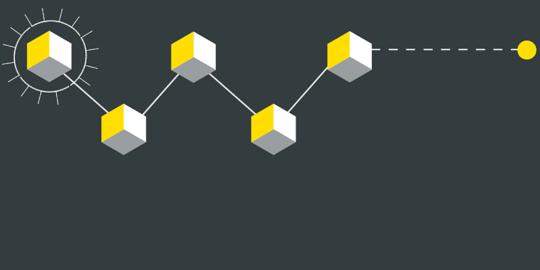The history of “disrupted” industries has one thing in common: At the beginning, the prevailing view in the industry is always that disruption could not happen to it. Persons tend to believe that they and their enterprises are irreplaceable, and therefore un-disruptable. The classical narrative of an industry about to be disrupted is: We have been doing this for ages, and we cannot find a way to do it better. Therefore, we assume, no one can.
We all know examples where such predictions were made, and later proven wrong. There are examples of entire industry sectors that where turned upside down by a new competitor, or by a new way of doing business.
If storm comes up, some people build shelters – others build windmills
There are also examples of industries that faced disruption, but made a quick turnaround and survived without much damage. As lawyers at Bird&Bird, we advise enterprises in just this situation. Our Munich office even hosts a competition dedicated to disruptive innovations, the Bird&Bird Disruptive Technology Challenge.
While we understand a lot about how businesses react to disruption, it is time to ask ourselves that same question. Are lawyers in the same situation? Is our own industry, the legal industry, also subject to disruptive forces?
Is the legal industry about to be disrupted?
Predictions are difficult in a field where so much is happening at once. But one thing is obvious: There are currently a lot of lawyers, arguing: No, this cannot happen to us. Legal service is a handmade service, and lawyers cannot be replaced by machines.
I am not so sure about this. Digitisation is now influencing all industries, including those without much exposure to digital tech. However, with increases in connectivity, and advanced human-machine interaction becoming a day-by-day experience, all industries, in principle, can be disrupted by digitisation. Why not the law?
How to survive
Disruption often occurs when a basic factor to which an industry is reliant, changes. The first players to realize this (and to react) become first movers, and probably disruptive forces. One famous example is Airbnb, which exploited the fact that digital tech had lowered transaction costs so much that private persons could start to offer their own accommodation services. Other examples relate to the disappearance of technical limitations, if these limitations had previously shaped an industry. As the limitations fade, they also cease to be relevant as elements of the business models. Think of newspapers, printed on paper and delivered as hard copies – and their increasing replacement by apps and websites. Think of broadcasters and their increasingly relevant competitors, the VoD platforms. Think of smoke tobacco and electrical vaporizers.
The first and most important thing to understand about disruption from the perspective of an established player (including lawyers), is: You cannot wait until it is too late. You have to be on the watch for elements of your business that are about to change rapidly.
In summary, the first step of surviving disruption is to detect (and accept) that there are developments that may become disruptive, unless mitigated. A good way to spot such a development early is to look for an idea that is so good that it is blatant, once it is set into practice.
The second step to survive disruption is to react quickly, and thoroughly. Disruption occurs the strongest when the mainstream of an industry neglects a fundamental development, instead of adapting to it. Often, such neglecting is not driven by ignorance, but by fear of self-cannibalization. The example of what happened to Kodak (and why) proves this well. Nonetheless, ignoring an issue has rarely helped resolving it. Or, as Victor Hugo phrased it: Nothing is as strong as an idea whose time has come.
What could disruption do to legal practice?
If we look for a disruptive element in the field of legal practice, I consider tech-driven industrialisation to be the most important. Let me explain.
In business terms, legal practice provision has always been “artisanal” – each client is served individually. Each client receives a service tailored directly to their needs. In that regard, law practice today has many things in common with traditional shoemaking.
The shoemaking industry and industrialisation
Until about 1850, shoes were made individually for each buyer. This made the shoes well-fitting, but also expensive. And since each shoemaker was working in his own small shop, there was not much innovation. Shoemakers learned individually, but not much collectively, and there was little overall progress for the shoemaking practice in general.
Due to the industrialisation process beginning around 1850, the shoemaking business today is entirely different. Shoes are assembled in industrial factories. All shoes of a product line are the same, with only very few adaptions (such as sizes) possible for the single buyer. Shoemaking companies invest their resources in producing a shoe type as such, before they assemble the individual shoes. The costs allocated to such development can be described as “First Copy Costs”: Costs for creating the “first copy”, i.e. the original that is to be used as template for all other products. Industrialisation means that this first copy can be reproduced at a fraction of the costs. Return of investment therefore is generated by selling very large number of copies (economies of scale). The quality of the first copy becomes increasingly relevant as the costs of producing “second copies” (incremental costs) decline.
This is in a nutshell why industrialisation changed the shoemaking practise so profoundly: Industrial production techniques lowered the costs for reproducing shoes. Industrialisation made it possible (and necessary) to invest in first copies, i.e. the type of a shoe, separately and profoundly, before the shoes are later assembled in large numbers. This led to the rapid disappearance of almost all shoemaker shops, and their replacement by the shoe-producing industry.
Legal practice is not shoemaking. The main difference is obvious: If you have a bad shoe, you get only blisters. But if you get a bad legal service, you will probably lose your property, a lot of money or even your freedom. In any case, you will likely lose much more as what you saved by electing to use a cheap legal service. This is why good lawyers are costly, but bad lawyers are even costlier. The same applies to bad – because untailored – legal services.
Tailored legal services are costly, but untailored services are costlier
Due to the risks usually at stake when lawyers are involved, it is simply not affordable for clients to use a legal service that is not tailored to them, and therefore may be missing just the feature they need. And this is important, because clients, when contacting a lawyer, often have no clear understanding of their problem. The first part of legal advice is often to identify the problem, even before a solution can be proposed. This is one of many reasons why lawyers are so obsessed with details: A single particularity of the case – sometimes obscure in the eyes of the client – is often the difference between success and defeat. Or between getting a contract that will help you solve your problems during the contract period, and a contract that will get you in trouble.
Are fully automated (“industrialised”) measures up to such tasks? I don´t think so. Lawyering requires human-human interaction, creativity, language processing at the highest level, deep understanding of how a society works, and a sort of experience that can (currently) only be gained by humans. Therefore, human lawyers, at least for the next ten years or so, will be irreplaceable.
But then, this does not mean that the legal practice cannot be changed profoundly by digitisation. Because, while some parts of the work done by a lawyer cannot be replaced by machines – and therefore be industrialised – others can. Some of what lawyers do today individually can be digitised, and therefore industrialised. Think again of the First Copy Costs: Which parts of a lawyer´s service can be used repeatedly? Where could a law firm invest to develop a type of legal service, before using it – in an adapted form – for a large number of cases?
If you look at what is currently happening in practice, you will find many such situations. In practise almost all lawyers have privately created some sort of instrument that supports them in work steps they perform repeatedly. Often these tools are makeshift solutions, such as word documents with boilerplate texts or excel documents. Sometimes they are more advanced flowcharts. Usually these tools do not go beyond do-it-yourself constructions, based on Microsoft Office, and are not shared with colleagues.
Legal industrialisation is about to happen
This is exactly where industrialisation of the legal practice could happen. Not by replacing lawyers, but by enabling them to leverage their work. The tools of legal industrialisation could enable lawyers to repeat work steps at a fraction of the costs, and to improve the quality of these work steps over time. These tools could also enable lawyers to make their procedures available to others. Think of the best contract law experts of a firm developing standard contract clauses – and methods to enable other, less-experienced lawyers of the firm to use them correctly. Think of complex regulatory assessments – and ways to make such assessments repeatable at a fraction of the costs.
It is blatant that this would be a game changer of the legal business as we know it today.
Another, probably not so blatant example how legal work can be leveraged is legal databases. Creation of legal data is already a large part of the work done in big law firms – even when this is usually not seen as creation of data. However, it is. For example, the larger parts of Due Diligence reports, or of some complex legal assessments, are essentially databases.
For the time being, such “databases” are usually delivered as a table in a Word-document, or in an Excel-file. It is obvious that this limits the way such data can be used. Written tables cannot be interpreted by software.
An example of a more modern format that shows what can be done with legal data when it is produced in a computable form is the Contract Risk Assessment Tool produced by Bird & Bird.
The Contract Risk Assessment Tool is a tool that shows, in a convenient and adaptable way, the risks connected to a batch of contracts.
What does this mean for the legal industry?
Sooner or later, the legal industry is going to make use of the new opportunities. This is unlikely to lead to lawyers being replaced by machines anytime soon. Contrary to what Richard and Daniel Susskind have claimed in their book “The Future of Professions”, industrialisation of the legal practice is not end of the professional era as such, at least not for lawyers.
Instead, lawyers are likely to start working with tools that enable them to provide part of their services in an industrial fashion. This is already happening in some of the more innovative boutiques and currently spreading to the big law firms. At some point it will probably affect the entire practice. During this development, the functions of lawyers will likely differentiate, even more as they already have. There will be less multi-purpose “lawyers”, and more specialists for different types of legal work. There will be more differentiation between front and back office, and changing job profiles on both sides. We will presumably see some new roles, such as legal project management specialists. And there will probably be roles resembling the job of data providers, or of “legal engineers”, who develop and maintain the tools to provide legal services.
It is also possible that a new form of value chain could emerge. Why should legal services always be produced from scratch by each firm? If a law firm invests heavily and produces a useful asset, for example a legal database, that asset could be licensed to others law firms. If a law firm has developed tools or data that enable companies to perform for example a GDPR Gap-Analysis, why not license, rent or sell such a tool?
There are of course many factors unknown; we yet have to see what the spoken and unspoken rules of legal tech will become. But one thing is sure: Lawyers have some challenges ahead of them.





